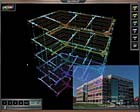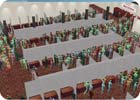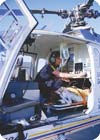Access Control: Simulate an Evacuation--New Business Basic

Read or listen to any news segment lately and you are likely to find at least one story on evacuation drills. States, cities, schools and businesses have recently focused much of their attention on devising and testing the latest and greatest in evacuation plans.
In the aftermath of hurricanes Katrina and Rita, and the tsunami in Thailand, amid growing concern over a possible avian flu pandemic and with the tragic events of 9/11 still on our minds, we feel a pressing need to conduct emergency evacuation drills. While having an effective evacuation plan is vital to the safety of our citizens, it is not clear that the benefits of these physical drills even begin to justify the costs involved.

There are hidden costs, too
Physically evacuating people requires a tremendous amount of resources, not to mention the hidden cost of lost productivity. Moreover, these exercises are typically announced to avoid unnecessary panic. There seems to be an inherent flaw in using an announced drill to measure readiness for a sudden crisis. Those assessing the evacuation plans will never observe the true outcomes of such a plan if the individuals involved do not behave as if it were an actual emergency.
Even if the costs to perform the drills are minimal, the limited extent to which announced drills can accurately recreate emergency scenarios leads to the question: What, if anything, do we learn from executing announced drills?
Rather than spend time and money executing drills that may not mimic reality, consider using simulation technology for evacuation planning. Simulation-based analysis provides opportunities to execute, test and observe the consequences of an infinite variety of evacuation scenarios. The software relies on actual population data, building layouts and statistical distributions representing passenger movement and other behaviors that influence the evacuation process. Consequently, this technology generates accurate and viable plans that work in actual emergency situations.
Stakeholders can identify different measures of effectiveness (such as time to evacuate, percent of the population contaminated, etc.) that will define success, run the simulation and immediately review the results of the scenarios. Simulation technology provides visual output as well as a suite of reports from which decision makers can evaluate the consequences of different evacuation plans.
Simulation doesn’t disrupt
One of the most valuable outcomes of incorporating this technology is that simulations conducted with this software can be recorded, reviewed and used later as a classroom training tool. With the click of a mouse, stakeholders can use evacuation scenarios to demonstrate lessons learned for employees, first responders and other individuals who might benefit. Unlike physical drills, evacuation software creates very little, if any, disruption to the affected community.
In addition, simulation technology relies on agent-based modeling that permits the assignment of a variety of behaviors to segments of the population, including panic, speed of exit and decision-making. Consequently, simulation technology provides stakeholders with opportunities to execute evacuation scenarios that accurate reflect the reality of the events.
The level of analysis performed with this technology depends on the needs of the customer. For example, one critical federal building experienced several incidents that required evacuations. To better prepare for these emergencies, the building security director requested simulation-based analysis to test a variety of scenarios and present observations, alternatives and recommendations. The Pentagon, on the other hand, required software tools that could determine guided routing that would work in concert with directional lighting.
Consequently, the technology became a real-time prototype building protection system for response to biochemical attacks. To this end, simulation-based technology offers stakeholders a suite of tools to analyze and adjust evacuation plans, generate reports on measures of effectiveness, provide evacuation training and, if necessary, communicate with other existing systems related to emergency response. Regardless of the needs of those involved in emergency preparedness, simulation-based technologies offer real solutions for the evacuation planning process.

SIDEBAR: How to Evacuate a CEO Long-distance
The chief executive gets sick on a business trip in the Pacific Rim or the chief financial officer is attacked in a Middle Eastern country. What’s the enterprise security executive to do?
There are corporate risk and insurance programs as well as specialty evacuation services that can react quickly.
For example, Access America of Richmond, Va., has an annual med evac service which provides worldwide medical transportation benefits up to $1 million. This extensive plan aims at frequent business travelers who are concerned about paying for the high cost of a medical transport out-of-pocket.
Fees for such services from numerous insurance and specialty firms vary widely depending upon distance and type of medical equipment and personnel needed, the cost of an evacuation can be financially devastating to an individual.

SIDEBAR: What Should Officers Carry on Duty?
While guard tour systems have an obvious role on patrol, such technology can make a difference during emergences and evacuations. For example, the director of security at the Cleveland Public Library equips his contract security officers with a guard tour system (from TimeKeeping Systems). Potential disasters and risks, according to Mike Janero, include water leaks. “Believe it or not, we are more concerned with water than fire problems. Water will do more damage than fire. We are also concerned about roof leaks. So, a lot of the (guard tour) buttons are by the fire pumps, sprinkler systems and by all kinds of pipes that have to be checked.”
Looking for a reprint of this article?
From high-res PDFs to custom plaques, order your copy today!


